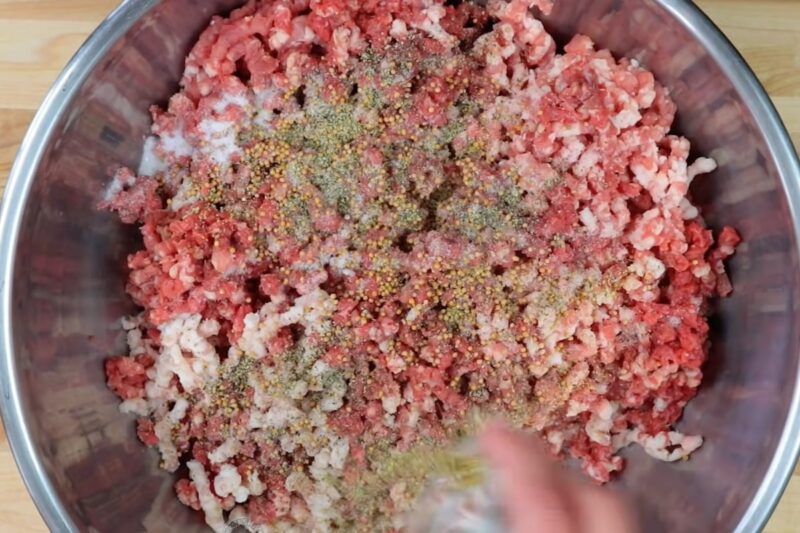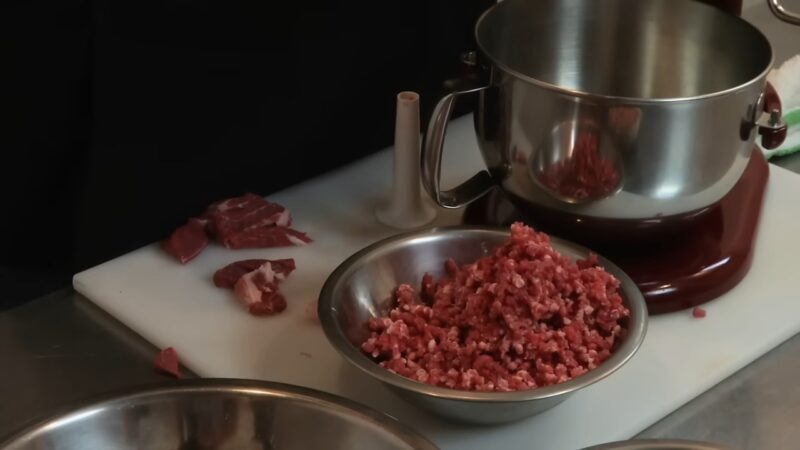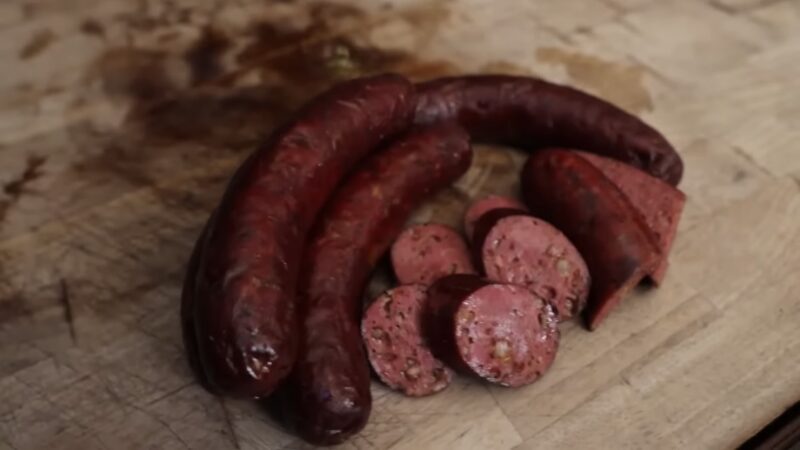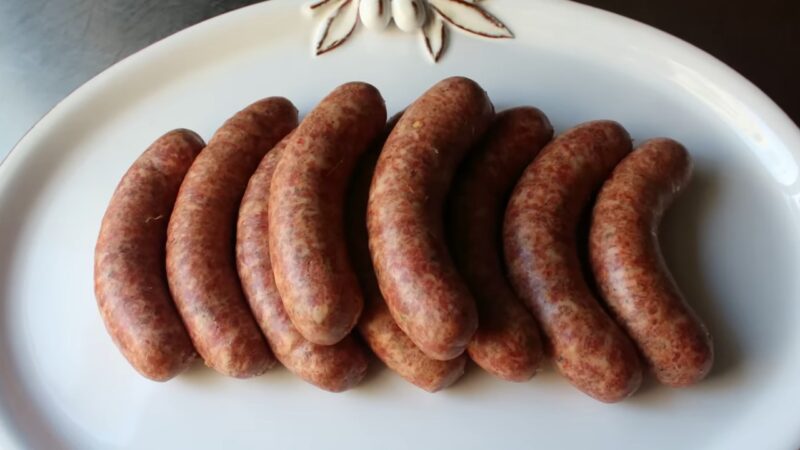If you’re craving the mouthwatering taste of homemade sausage, look no further. In this article, I’ll share a collection of irresistible sausage recipes and offer expert tips to help you perfect your sausage-making skills.
Key Takeaways:
- Homemade sausage allows you to control the ingredients and flavors.
- Explore different types of sausages like venison, beef, lamb, wild boar or pork, duck, goose, turkey, and other poultry.
- Invest in the right equipment such as a meat grinder and stuffer, and natural casings.
- Adding fat like bacon can improve texture and flavor.
- Essential ingredients for safety and flavor include salt, curing salt, and optional additives like dry milk or binders.
- Cooking methods for sausages include baking, grilling, or sautéing.
- Store homemade sausages in the refrigerator or freezer for later use.
- With practice and the right techniques, you can create your own delicious sausages at home.
Exploring Different Sausage Types and Flavors

Discover a world of sausage possibilities as we explore the different types of sausages you can make and the wide range of flavors you can create through ingredient choices and seasonings. Homemade sausage is a versatile and delicious option for meat lovers, allowing you to control the ingredients and tailor the flavors to your liking.
When it comes to sausage types, the options are endless. You can experiment with different meats like venison, beef, lamb, wild boar or pork, duck, goose, turkey, and other poultry. Each meat brings its own unique flavors and textures to the sausage. For example, venison sausage has a rich and gamey taste, while beef sausage offers a hearty and robust flavor. Mixing meats can also create interesting flavor combinations, such as beef and bacon sausage, which combines two beloved flavors in one delicious bite.
To further elevate the flavors of your homemade sausages, you can experiment with a variety of seasonings and ingredients. Spices like garlic, paprika, fennel, and chili powder can add depth and complexity to the flavor profile. Fresh herbs like rosemary, thyme, and sage can bring a vibrant and aromatic element. You can also add ingredients like cheese, sun-dried tomatoes, or even fruits like apples or cranberries to create unique and unexpected flavor combinations.
| Sausage Type | Meat | Seasonings | Flavors |
|---|---|---|---|
| Venison Sausage | Venison | Garlic, thyme, juniper berries | Rich, gamey |
| Beef and Bacon Sausage | Beef, bacon | Paprika, garlic, black pepper | Hearty, smoky |
| Turkey and Cranberry Sausage | Turkey | Sage, dried cranberries | Savory, slightly sweet |
With the right equipment, ingredients, and a bit of creativity, you can create your own unique and flavorful sausages at home. Whether you prefer mild and savory flavors or bold and spicy sensations, the world of homemade sausage is yours to explore and savor.
Essential Equipment and Ingredients for Homemade Sausage Making
To craft the perfect sausage, you’ll need the right tools and ingredients. In this section, we’ll cover the essential equipment and ingredients that every sausage maker should have on hand.
Equipment

The first and foremost tool you’ll need is a reliable meat grinder. This will allow you to grind your choice of meats to the desired consistency. Look for a grinder that offers different grinding plates to achieve the texture you prefer. Additionally, a sausage stuffer is essential for filling casings and shaping your sausages. There are both manual and electric options available, so choose one that suits your needs and preferences.
Another crucial piece of equipment is a meat mixer, which helps to evenly distribute the seasonings throughout the meat mixture. This ensures that every bite of your homemade sausage is packed with flavor. Lastly, don’t forget about natural casings, which are used to encase the meat mixture. They add an authentic touch and contribute to the overall texture and taste of your sausages.
Ingredients
When it comes to sausage making, the quality of your ingredients can make all the difference. Start with your choice of meat, whether it’s pork, beef, lamb, or poultry. Opt for lean cuts for a healthier option or use fattier cuts for a richer flavor and juicier texture. Adding some fat to leaner meats, like bacon, can help improve the texture and flavor of your sausages.
Seasonings are the key to creating unique and delicious flavors. Salt is a must for both flavor and food safety, so be sure to include it in your recipes. Curing salt is also essential, especially if you plan on smoking, curing, or storing your sausages for an extended period. Other seasonings and spices like garlic, paprika, black pepper, and fennel seeds can be used to tailor the taste of your sausages to your liking.
In addition to seasonings, you may choose to add other ingredients to enhance the texture and flavor of your sausages. Dry milk powder can improve the moisture and tenderness, while binders like breadcrumbs or soy protein concentrate can help retain juiciness and prevent dryness. Experiment with different combinations to find your perfect blend of ingredients!
| Equipment | Ingredients |
|---|---|
| Meat grinder | Choice of meat |
| Sausage stuffer | Salt |
| Meat mixer | Curing salt |
| Natural casings | Seasonings and spices |
Enhancing Flavor and Texture with Fat and Additives

Achieve mouthwatering results in your homemade sausages by learning how to balance fat content and incorporate additives that enhance both flavor and texture. When it comes to sausage making, fat plays a crucial role in creating a juicy and tender final product. Adding fat to leaner meats, such as bacon, not only improves the texture but also imparts a rich and savory taste. Experiment with different ratios of meat to fat to find the perfect balance that suits your preferences.
In addition to fat, there are a variety of additives that can take your homemade sausages to the next level. Salt and curing salt are essential for food safety and contribute to the overall flavor profile. They help in preserving the sausage and preventing the growth of harmful bacteria. Other additives, such as dry milk or binders, can improve the texture and give your sausages a moist and succulent bite.
To ensure the proper distribution of fat and additives, it is important to mix the ingredients thoroughly. Many sausage makers use a meat grinder with a sausage stuffer attachment to achieve a consistent blend. This equipment not only helps in grinding the meat and fat together but also enables seamless filling of the sausage casings. Natural casings, such as hog casings, are widely used and provide a traditional touch to homemade sausages.
Remember, cooking methods can also impact the flavor and texture of your sausages. Baking sausages in the oven can result in a juicy interior and a crisp exterior, while grilling imparts a smoky and charred flavor. Sautéing sausages in a pan can be a quick and convenient option. Whatever method you choose, make sure to cook the sausages thoroughly to ensure they are safe to consume.
| Additive | Function |
|---|---|
| Salt | Enhances flavor, preserves sausage |
| Curing salt | Preserves sausage, prevents the growth of bacteria |
| Dry milk | Improves texture, adds moisture |
| Binders | Enhances texture, provides cohesiveness |
Experimenting with different fat and additive combinations is part of the fun in sausage making. Feel free to get creative and try new flavors to suit your taste buds. With the right techniques and ingredients, you can elevate your homemade sausages to gastronomic heights.
Cooking Methods and Storage Tips

From grilling to sautéing, explore a variety of cooking methods that will bring out the best in your homemade sausage creations. Whether you prefer the smoky char of a grill or the rich flavors developed through slow simmering, there’s a cooking method to suit every taste.
Grilling is a popular choice for sausages, as it imparts a delicious smoky flavor and creates a crispy exterior. Preheat your grill to medium-high heat and place the sausages over direct heat. Cook for 10-12 minutes, turning occasionally, until the sausages are browned and cooked through. To enhance the flavor, consider adding wood chips or herbs to the grill for a subtle infusion of aroma.
If grilling isn’t an option, sautéing your sausages on the stovetop is another great choice. Heat a skillet over medium heat and add a small amount of oil or butter. Place the sausages in the skillet and cook for 10-12 minutes, turning occasionally, until browned and cooked through. You can also add onions and peppers to the skillet for a delicious sausage and peppers dish.
When it comes to storing your homemade sausages, it is crucial to follow best practices to ensure food safety and preserve quality. After cooking, allow the sausages to cool completely. Store them in an airtight container or wrap them tightly in plastic wrap. Refrigerate for up to four days or freeze for longer-term storage. To prevent freezer burn, wrap the sausages in heavy-duty foil or place them in a freezer-safe bag.
Table: Cooking Times for Homemade Sausages
| Cooking Method | Estimated Cooking Time |
|---|---|
| Grilling | 10-12 minutes |
| Sautéing | 10-12 minutes |
Remember, practice makes perfect when it comes to sausage making. Don’t be afraid to experiment with different cooking methods and flavors to find your perfect homemade sausage recipe. With the right techniques and a touch of creativity, you can enjoy restaurant-quality sausages right in the comfort of your own home.
Mastering the Art of Homemade Sausage Making

Want to elevate your sausage-making skills? Follow these insider tips and techniques to become a true master of the craft.
1. Use quality ingredients: To create flavorful sausages, start with high-quality meats and fresh ingredients. Look for cuts of meat with a good balance of fat and lean meat for the best results.
2. Experiment with seasonings: Don’t be afraid to get creative with your flavor combinations. Try different herbs, spices, and seasonings to personalize your sausages. Keep notes of the ingredients and proportions you use, so you can replicate successful recipes.
3. Keep everything cold: It’s crucial to keep the temperature of your meat and equipment cold throughout the sausage-making process. This helps maintain texture and ensures proper mixing and grinding.
| Essential Equipment: | Ingredients: |
|---|---|
| Meat grinder | High-quality meats |
| Sausage stuffer | Fresh herbs and spices |
| Natural casings | Salt and curing salt |
| Cold storage for chilling | Additional additives (optional) |
4. Grind the meat: Start by grinding your meat using a meat grinder, ensuring a consistent texture for your sausages. Keep the ground meat cold during this process to maintain its quality.
5. Mix well: Combine the ground meat with your chosen seasonings and mix thoroughly. Use your hands or a mixer on low speed to evenly distribute the flavors throughout the meat.
6. Stuff the casings: Attach the sausage stuffing attachment to your meat grinder or use a dedicated sausage stuffer. Fill the natural casings with the meat mixture, being careful not to overstuff or leave air pockets.
7. Cook and enjoy: Cook your homemade sausages using your preferred method, whether it’s grilling, baking, or sautéing. Remember to cook the sausages thoroughly to ensure food safety.
With practice and experimentation, you’ll soon become a master of homemade sausage making. So gather your ingredients, follow these tips, and get ready to enjoy the flavors of freshly made sausages right in your own kitchen.
Venison Sausage Recipe

Indulge in the rich and savory flavors of venison with this delectable homemade venison sausage recipe. Venison sausages are a popular choice among meat lovers, offering a unique and delicious alternative to traditional pork or beef sausages. With the right combination of ingredients and seasonings, you can create a mouthwatering sausage that is sure to impress your family and friends.
| Ingredients | Quantity |
|---|---|
| Ground venison | 2 pounds |
| Pork fat, cubed | 1 pound |
| Garlic powder | 2 teaspoons |
| Onion powder | 2 teaspoons |
| Ground black pepper | 2 teaspoons |
| Salt | 2 teaspoons |
| Dried thyme | 1 teaspoon |
| Dried rosemary | 1 teaspoon |
| Cayenne pepper | 1/2 teaspoon |
To make the venison sausage, start by combining the ground venison and pork fat in a large mixing bowl. Mix well to ensure the fat is evenly distributed throughout the meat. Add the garlic powder, onion powder, ground black pepper, salt, dried thyme, dried rosemary, and cayenne pepper to the bowl. Use your hands or a fork to mix the seasonings into the meat.
Once the mixture is well combined, it’s time to shape the sausages. Take a handful of the meat mixture and shape it into a sausage shape, about 4-6 inches long. Repeat until all of the mixture is used. If desired, you can also stuff the mixture into natural casings for a more traditional sausage appearance.
To cook the venison sausages, preheat your grill or stovetop skillet to medium-high heat. Place the sausages on the grill or skillet and cook for about 4-6 minutes per side, or until the internal temperature reaches 160°F (71°C). Remove the sausages from the heat and let them rest for a few minutes before serving. Enjoy the delicious flavors of homemade venison sausage!
Beef and Bacon Sausage Recipe
Treat your taste buds to the perfect combination of beefy goodness and savory bacon with this irresistible homemade sausage recipe. Crafted with love, this recipe is sure to become a family favorite. Gather your ingredients and let’s get started!
Ingredients:
- 2 pounds of ground beef
- 1 pound of bacon, finely chopped
- 2 teaspoons of salt
- 1 teaspoon of black pepper
- 1 teaspoon of garlic powder
- 1 teaspoon of paprika
- 1/2 teaspoon of dried thyme
- 1/2 teaspoon of dried rosemary
- 1/4 cup of ice water
Instructions:
- In a large bowl, combine the ground beef, bacon, salt, black pepper, garlic powder, paprika, thyme, and rosemary. Mix well until all the ingredients are evenly distributed.
- Slowly add the ice water to the mixture, a little at a time, while continuing to mix. This will help bind the ingredients together and create a smoother texture.
- Shape the mixture into sausage links or patties, depending on your preference. If using natural casings, follow the instructions provided to stuff the sausage mixture into them.
- Preheat your grill or stovetop skillet to medium-high heat. Cook the sausages for about 4-5 minutes per side, or until they are fully cooked and reach an internal temperature of 160°F (71°C).
- Remove the sausages from the heat and let them rest for a few minutes before serving. Enjoy your homemade beef and bacon sausages with your favorite sides or add them to your favorite recipes!
Tips:
- To add extra flavor, consider using smoked bacon or adding additional spices like chili powder or cayenne pepper to the mixture.
- If you don’t have a meat grinder, you can purchase pre-ground beef and finely chop the bacon to achieve similar results.
- For a milder flavor, you can reduce the amount of bacon used or opt for leaner cuts of beef.
Now that you have the recipe for these delectable beef and bacon sausages, get creative with how you serve them. Whether it’s in a bun with your favorite toppings or as a flavorful addition to pasta dishes, these sausages are sure to impress. So fire up the grill or heat up the skillet, and enjoy the mouthwatering combination of beef and bacon in every bite!
| Ingredients | Quantity |
|---|---|
| Ground beef | 2 pounds |
| Bacon, finely chopped | 1 pound |
| Salt | 2 teaspoons |
| Black pepper | 1 teaspoon |
| Garlic powder | 1 teaspoon |
| Paprika | 1 teaspoon |
| Dried thyme | 1/2 teaspoon |
| Dried rosemary | 1/2 teaspoon |
| Ice water | 1/4 cup |
FAQ
What types of sausages can I make at home?
You can make various types of sausages at home using meats such as venison, beef, lamb, wild boar or pork, duck, goose, turkey, and other poultry.
What equipment do I need for homemade sausage making?
To make homemade sausage, you’ll need a meat grinder and stuffer, as well as access to natural casings for the sausage.
How can I enhance the flavor and texture of my homemade sausages?
Adding fat to leaner meats, such as bacon, can help improve the texture and flavor of your homemade sausages. You can also use additives like dry milk or binders to enhance the texture.
Can you recommend a recipe for beef and bacon sausage?
Absolutely! In our recipe section, you’ll find a mouthwatering recipe for beef and bacon sausage, combining two beloved flavors.
Final Words
Making homemade sausages offers a chance to customize flavors and ensure quality ingredients. From venison to poultry, there’s a recipe to suit every palate.
Essential tools like a meat grinder and stuffer simplify the process, while natural casings enhance authenticity. Experimentation with seasonings added fats, and binders can elevate texture and taste. Prioritize safety by using salts and curing agents.
Homemade sausages can be baked, grilled, or sautéed and stored for later use.

